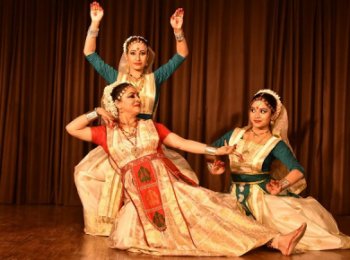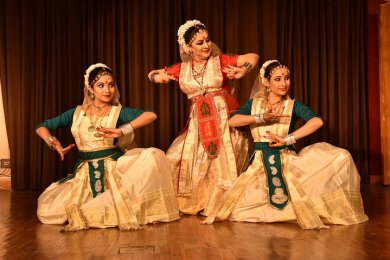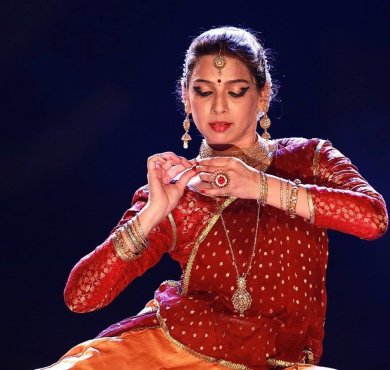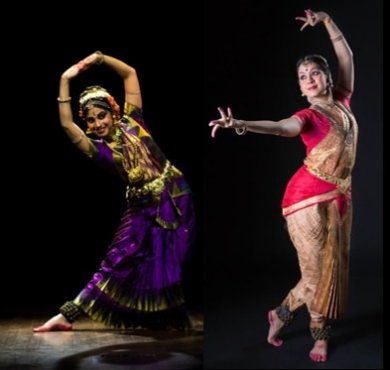
|   |

|   |
 e-mail: leelakaverivenkat@gmail.com Women and Ecology March 24, 2019 A three day festival on Woman and Nature, recalling passages from traditional arts, from culture and lifestyle studies not omitting folklore, held at the IGNCA, saw the Sattriya exponent Mallika Kandali perform along with her group. Divya Prakriti Parva focused on woman's role in preservation and conservation of ecology and environment. The dancer naturally had to go back to the work of Sankaradeva, the Neo Vaishnavite reformer (1449-1568), credited as the father of the Sattriya tradition. In his ritual plays (Bhaona), though a direct reference to women in the mentioned role is hard to come by, his female characters like Rukmini and even Sita for instance are very strong people, far from the weepy, cringing types. But the reformist was very conscious of ecology sustained with a belief that every micro aspect of the cosmos reflected the macro identity of the Infinite. Sensitive to nature as Sankaradeva was, one comes across delightful verses describing nature in different moods, and through the description of seasons, and how women responded to them one could deduce and arrive at some ideas on how emotively women related to nature. The female characters in Sankaradeva's plays while not clinging vines compared in literature to creepers, had their beauty like that of Mohini compared to various flowers.   Mallika Khandali and group Photos courtesy: IGNCA, Delhi By an intelligent selection of excerpts from Sankaradeva's Kirtana Ghosha and Ankia Nat, Mallika's Sattriya conceptualization and choreography established a woman/nature connection. Mallika with her disciples Angshumala Dutta and Priyakshee Kataky, began with Slokar Nach, dedicated to evoking Sattriya's dance deity Krishna, the dancers in the Stree Ora (the main stance for the female dancer) performing soft movements including the typical Sattriya scissored crossed feet moving forwards. After just the Ramdani nritta part of Jhumura (comprising small plays of Madhavadeva (Sankaradeva's prime disciple) presented by a male performer Kiron Bora with music by late Guru Murari Sharma, came Varsha Varnan from Sankaradeva's verses comprising the description of the monsoon season, with thunder followed by rains. Basking in the rains are women and animals and it is as if the whole of nature comes together. After Vrikhya Varnan visualizing nature in full bloom with a tree full of the weight of blossoms (Ghana phule dhari) with gentle breezes blowing in the fragrance of Lavanga, Malati, Champaka, creepers of Kumuda, Indu, and trees like the Kadamba, the Parijata, the Kalpataru - with all this profusion, attracting birds like the cuckoo and other animals, came Vrikhya Sakhi. This part portrays Gopis, restless in the absence of Krishna, ardently searching for him, enquiring of every flower, leaf, tree, bird and peacock about the Lord's whereabouts (Koita paibu Prana Gopala?). With the taped music by Bhupen Nath, and Mallika's evocative abhinaya, one perceived the close nature/woman connection. In fact there is a hidden sensuality in the Gopis diagnosing in some trembling leaves the lingering after effects of ecstasy after touch and contact with Krishna - who must have passed that way but recently. Aside from Mallika's own capacity for communicative interpretation, the disciples added grace and poise to the performance. IIC'S Double Bill Festival attracts audiences Begun last year, ICCR's Double Bill Concert with two main performances scheduled in one day seems to have caught the imagination of viewers, attracting a good audience - something dance concerts have been missing very often in Delhi. Late Kathak veteran Rohini Bhate's disciple Rujuta Soman (continuing her training now in laya/taal under Suresh Talwalkar, and dance under Rajendra Gangani) carrying her main guru's hallmark in many ways proved why Bhate was so valued in the classical world. First in the aesthetics of programming and then in the excellent grasp over technique and rhythm and not least in the classical excellence of the musical accompaniment, one saw that Rujuta's years under Rohini Bhate were not in vain. Nikhil Pathak on tabla, Naseer Khan on the sarangi, Mrunmaye Pathak providing tuneful vocal support with Haripriya on the harmonium, and Tulsi Kulkarni and Shivangi Manke providing parhant support comprised a competent team. The dancer began with a composition of Rohini Bhate - an invocation to a rare vision of Ganesh, the "sindura vadana, madana sundara, Lambu udara" who is worshipped here as the embodiment of music and dance -epitomizing in his person the naad on the veena, the percussion on the mridanga vadan and the rhythm of dance. The teental nritta part was a joy to behold. Rujuta literally played with the tala and the ease with which she handled footwork passages with changing accents (almost leading the tablist) showed the absolute control over measurement of time. In a slew of unusual selection of intra-forms, the dancer presented Late Durga Lal's Uthan, Bijli Uthan with takeoff before the 'sama', Rohini Bhate's Paran Amad and her Kali Paran in khandajati finishing in raudra roopa, a Paramparic Gangani Paran set in tisra/misra/chatusra in that order, and her own Gat Bhav built round the adhama nayika Pootana. The dancer also showed how, like Bhav Thata, Bhav Toda, Bhav Paran, pure dance abstract bandishes in their tone and gait could suggest moods of interpretation. The abhinaya segment was based on a Dadra by late Girijadevi, wherein the artist sees Krishna everywhere - in her breath, her thoughts, and deeds - in fact so lost in Krishna contemplation is she that all sense of duality is lost with her own Being submerged in that which she craves. The singer's melodious support, with the dancer's involvement made the difference. With her stage presence and aesthetic getup, here is a Kathak dancer who can hold audience attention.  Rujuta Soman  Payal Ramchandani & Arupa Lahiry Photos courtesy: IIC Arupa Lahiry, a disciple of Chitra Visweswaran, and Payal Ramchandani who has trained under the Reddy couple, the Rao couple and also Mosalikanti and Padmavani, in a Bharatanatyam/Kuchipudi duet took the stage during the second half. They chose to pin their performance for the main part on Swati Tirunal's 'Bhavayami Raghuramam' in Ragamalika. While based on the Ramayana, the sahitya content, through various roles in the narrative, offers great theatrical opportunity - very much in the dramatic mode of Kuchipudi particularly. While Payal took on the more aggressive roles, Arupa with greater height, was Rama who broke the bow and Payal, the bashful Sita. While the sharing of stage space in simultaneity was astutely dealt with, the Bharatanatyam/Kuchipudi stylistic contrasts were only minimally visible thanks to character portrayals occupying the attention in this narration of the story of the Ramayana. While both dancers gave convincing performances, I felt that Payal could have toned down her expressions to greater subtlety. With more purely rhythmic interludes, the chances for bringing out stylistic movement identities of the two forms would have been heightened. Instead of a nritta item following the long opening composition with enough accommodation for mimetic skill, which would have been right for the time slot allowed, the dancers chose to present solo abhinaya compositions. Arupa chose the Purandaradasa composition "Saddu maadalu bedavo Ranga". Entreating Krishna not to draw the attention of people and tempt gossip, the nayika begs that he resist pulling her pallav, making the waist band jingle, or playing the flute. There was restraint in her portrayal. Payal who is a much evolved dancer from what one saw of her some years back, chose Sanskrit verses from Chaura Panchakshika - wherein the hero who is assigned to teach Yamini falls in love with her, with his feelings fully reciprocated (despite all the duplicitous moves made to prevent any closeness between the two) and when discovered, Chaura is sentenced to death. In his death cell, his thoughts are of Yamini, comparing her beauty to a garland of Champaka, her grace to that of a gazelle and he wonders as to her reaction and fate when she hears of his execution. Presented to music composed by Kuldip Pai, Ramchandani's expressional skills were in full cry. Here again the natural ability to emote could do with more disciplining. The abhinaya items being too long the time limit was crossed when the concluding item of a Tillana was announced.  Writing on the dance scene for the last forty years, Leela Venkataraman's incisive comments on performances of all dance forms, participation in dance discussions both in India and abroad, and as a regular contributor to Hindu Friday Review, journals like Sruti and Nartanam, makes her voice respected for its balanced critiquing. She is the author of several books like Indian Classical dance: Tradition in Transition, Classical Dance in India and Indian Classical dance: The Renaissance and Beyond. Post your comments Please provide your name and email id when you use the Anonymous profile in the blog to post a comment. All appropriate comments posted with name & email id in the blog will also be featured in the site. |